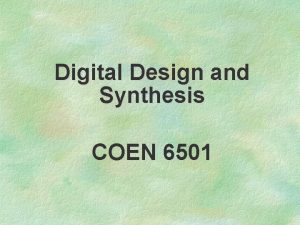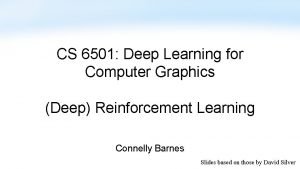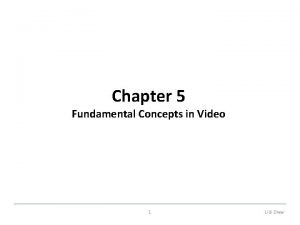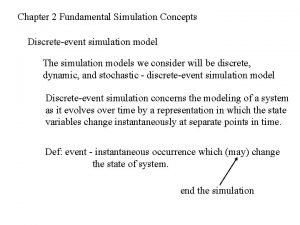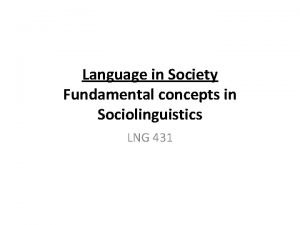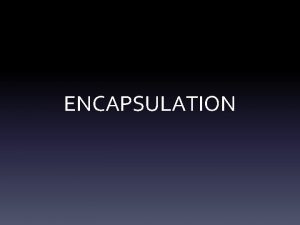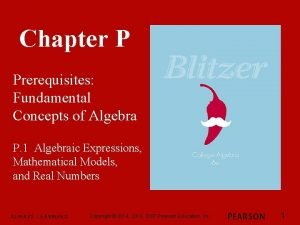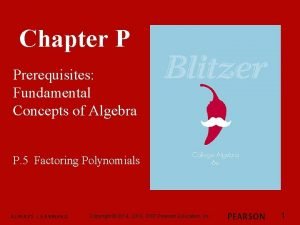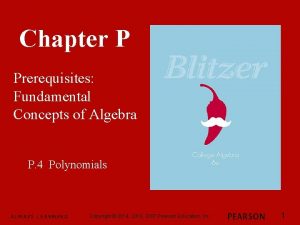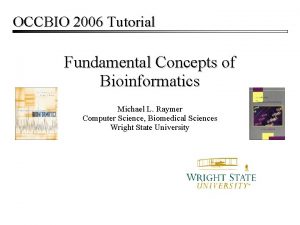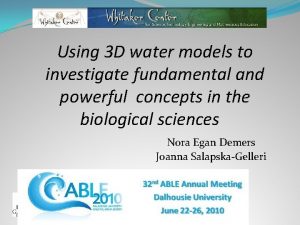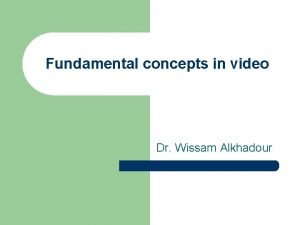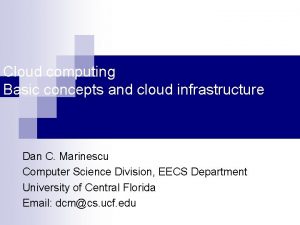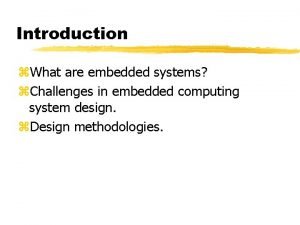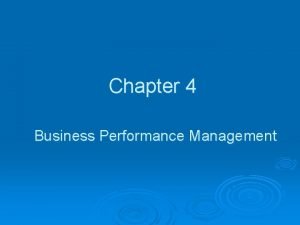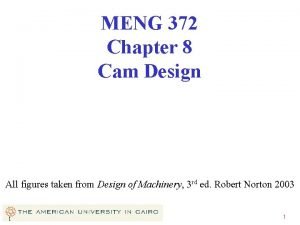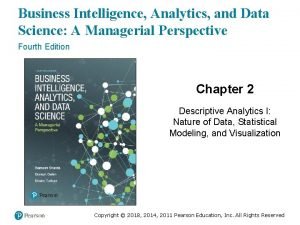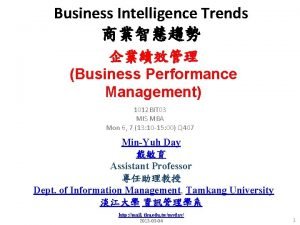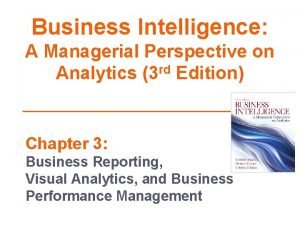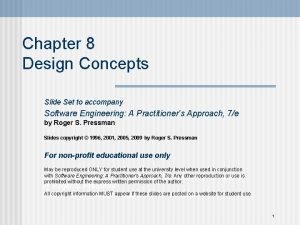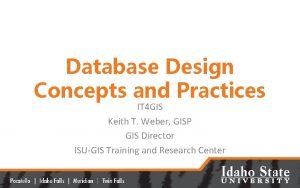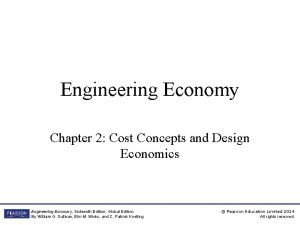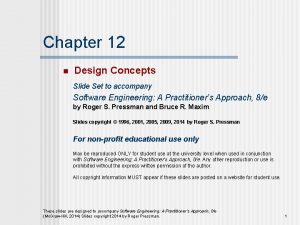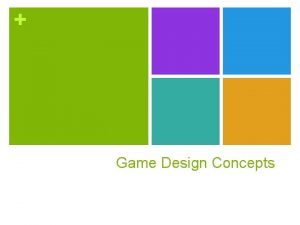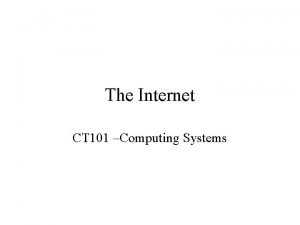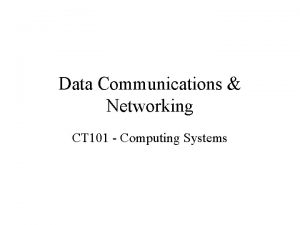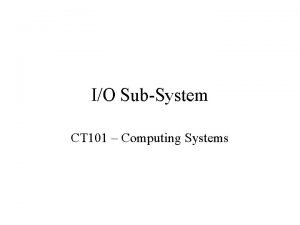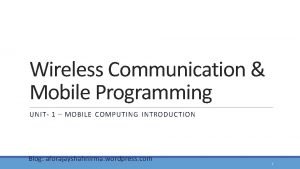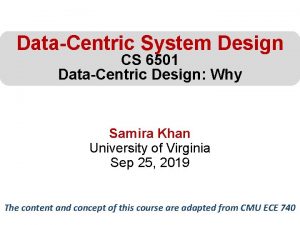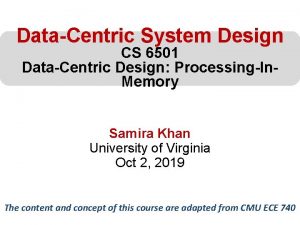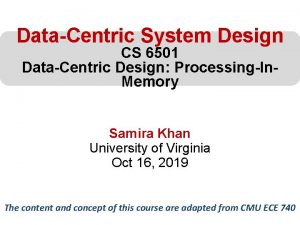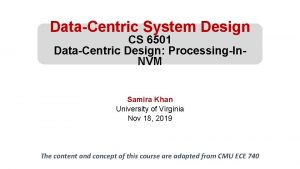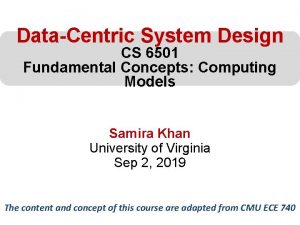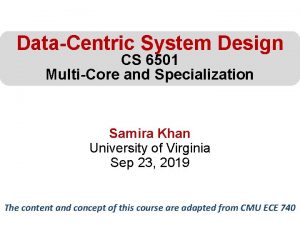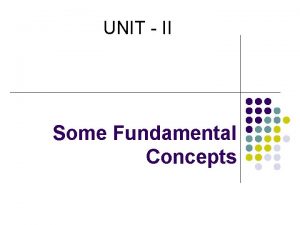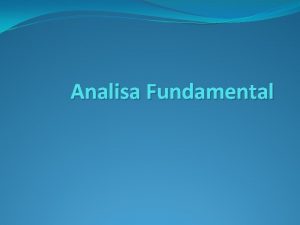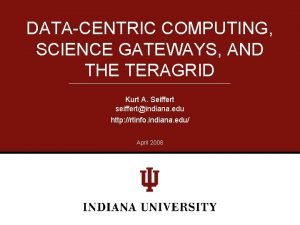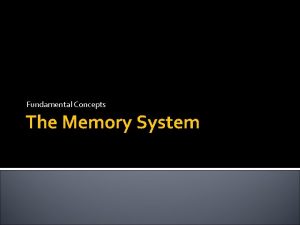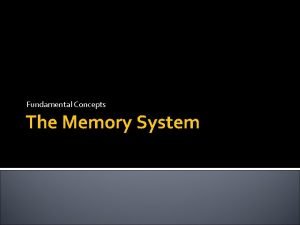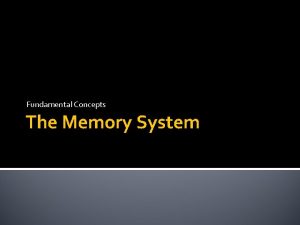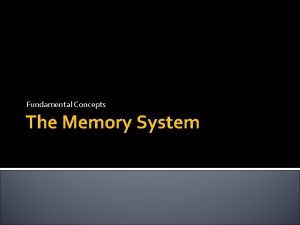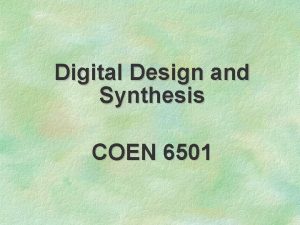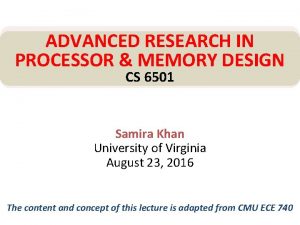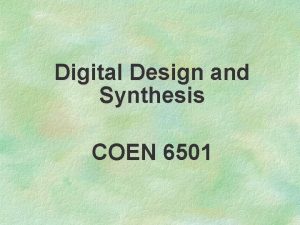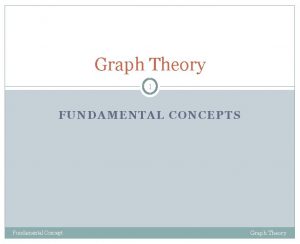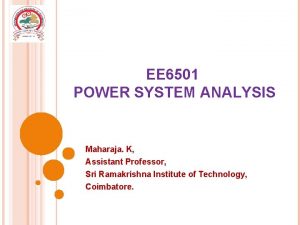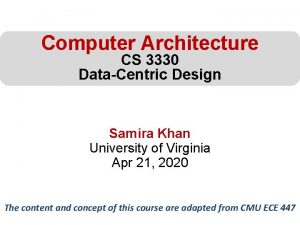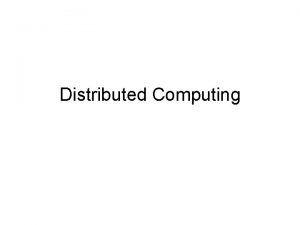DataCentric System Design CS 6501 Fundamental Concepts Computing





































- Slides: 37

Data-Centric System Design CS 6501 Fundamental Concepts: Computing Models Samira Khan University of Virginia Sep 4, 2019 The content and concept of this course are adapted from CMU ECE 740

Review Set 2 • Due Sep 11 • Choose 2 from a set of four • Dennis and Misunas, “A Preliminary Architecture for a Basic Data Flow Processor, ” ISCA 1974. • Arvind and Nikhil, “Executing a Program on the MIT Tagged-Token Dataflow Architecture”, IEEE TC 1990. • H. T. Kung, “Why Systolic Architectures? , ” IEEE Computer 1982. • Annaratone et al. , “Warp Architecture and Implementation, ” ISCA 1986. 2

AGENDA • Logistics • Review from last lecture • Fundamental concepts – Computing models 3

THE VON NEUMANN MODEL/ARCHITECTURE • Also called stored program computer (instructions in memory). Two key properties: • Stored program – Instructions stored in a linear memory array – Memory is unified between instructions and data • The interpretation of a stored value depends on the control signals When is a value interpreted as an instruction? • Sequential instruction processing – One instruction processed (fetched, executed, and completed) at a time – Program counter (instruction pointer) identifies the current instr. – Program counter is advanced sequentially except for control transfer instructions 4

THE DATA FLOW MODEL (OF A COMPUTER) • Von Neumann model: An instruction is fetched and executed in control flow order – As specified by the instruction pointer – Sequential unless explicit control flow instruction • Dataflow model: An instruction is fetched and executed in data flow order – i. e. , when its operands are ready – i. e. , there is no instruction pointer – Instruction ordering specified by data flow dependence • Each instruction specifies “who” should receive the result • An instruction can “fire” whenever all operands are received – Potentially many instructions can execute at the same time • Inherently more parallel 5

VON NEUMANN VS DATAFLOW • Consider a Von Neumann program – What is the significance of the program order? – What is the significance of the storage locations? a b v <= a + b; w <= b * 2; x <= v - w y <= v + w z <= x * y + *2 - + Sequential * Dataflow z • Which model is more natural to you as a programmer? 6

MORE ON DATA FLOW • In a data flow machine, a program consists of data flow nodes – A data flow node fires (fetched and executed) when all it inputs are ready • i. e. when all inputs have tokens • Data flow node and its ISA representation 7

Dataflow Machine: Instruction Templates e od c Op 1 2 3 4 5 + * on ati n sti e D 3 L 3 R n 2 o i at 1 s De tin Op nd a r e 1 nd a r e 2 Op 4 L 4 R b a 1 2 + *7 x 5 L 5 R out 3 y 4 - + Presence bits Each arc in the graph has an operand slot in the program 5 * Dennis and Misunas, “A Preliminary Architecture for a Basic Data Flow Processor, ” ISCA 1974 • One of the papers assigned for review next week 8

Static Dataflow Machine (Dennis+, ISCA 1974) Receive Instruction Templates 1 2. . . FU Send Op dest 1 dest 2 p 1 src 1 FU FU p 2 FU <s 1, p 1, v 1>, <s 2, p 2, v 2> • Many such processors can be connected together • Programs can be statically divided among the processors src 2 FU

Static Data Flow Machines • Mismatch between the model and the implementation – The model requires unbounded FIFO token queues per arc but the architecture provides storage for one token per arc – The architecture does not ensure FIFO order in the reuse of an operand slot • The static model does not support – Reentrant code • Function calls • Loops – Data Structures 10

Problems with Re-entrancy x y X+1 X+1 Takes a long time • Assume this was in a loop • Or in a function Blocked • And operations took variable time to execute This node will fire 11 • How do you ensure the tokens that match are of the same invocation?

Monsoon Dataflow Processor 1990 12

Dynamic Dataflow Architectures • Allocate instruction templates, i. e. , a frame, dynamically to support each loop iteration and procedure call – termination detection needed to deallocate frames • The code can be shared if we separate the code and the operand storage a token <fp, ip, port, data> frame pointer instruction pointer

A Frame in Dynamic Dataflow 1 2 + 1 3 L, 4 L * 2 3 R, 4 R 3 4 5 - 3 5 L + 4 5 R * 5 out Program 1 4 5 L 7 *7 x 3 2 + <fp, ip, p , v> 1 b a y 4 - 5 + * Frame Need to provide storage for only one operand/operator

Monsoon Processor (ISCA 1990) op r d 1, d 2 ip Instruction Fetch fp+r Operand Fetch Code Frames Token Queue ALU Form Token Network Gregory M. Papadopoulos David E. Culler, Monsoon: an explicit token-store architecture, ISCA 1990

Procedure Linkage Operators f a 1 get frame extract tag change Tag 0 Like standard call/return but caller & callee can be active simultaneously token in frame 0 token in frame 1 an . . . change Tag 1 change Tag n 1: n: Fork Graph for f change Tag 0 change Tag 1

Loops and Function Calls Summary 17

DATA FLOW CHARACTERISTICS • Data-driven execution of instruction-level graphical code – Nodes are operators – Arcs are data (I/O) – As opposed to control-driven execution • Only real dependencies constrain processing • No sequential I-stream – No program counter • Operations execute asynchronously • Execution triggered by the presence of data 18

DATA FLOW ADVANTAGES/DISADVANTAGES • Advantages – Very good at exploiting irregular parallelism – Only real dependencies constrain processing • Disadvantages – Debugging difficult (no precise state) • Interrupt/exception handling is difficult (what is precise state semantics? ) – Too much parallelism? (Parallelism control needed) – High bookkeeping overhead (tag matching, data storage) – Instruction cycle is inefficient (delay between dependent instructions), memory locality is not exploited 19

DATA FLOW SUMMARY • Availability of data determines order of execution • A data flow node fires when its sources are ready • Programs represented as data flow graphs (of nodes) • Data Flow at the ISA level has not been (as) successful • Data Flow implementations under the hood (while preserving sequential ISA semantics) have been successful – Out of order execution – Hwu and Patt, “HPSm, a high performance restricted data flow architecture having minimal functionality, ” ISCA 1986. 20

OOO EXECUTION: RESTRICTED DATAFLOW • An out-of-order engine dynamically builds the dataflow graph of a piece of the program – which piece? • The dataflow graph is limited to the instruction window – Instruction window: all decoded but not yet retired instructions • Can we do it for the whole program? • Why would we like to? • In other words, how can we have a large instruction window? 21

ANOTHER WAY OF EXPLOITING PARALLELISM • SIMD: – Concurrency arises from performing the same operations on different pieces of data • MIMD: – Concurrency arises from performing different operations on different pieces of data • Control/thread parallelism: execute different threads of control in parallel multithreading, multiprocessing – Idea: Use multiple processors to solve a problem 22

FLYNN’S TAXONOMY OF COMPUTERS • Mike Flynn, “Very High-Speed Computing Systems, ” Proc. of IEEE, 1966 • SISD: Single instruction operates on single data element • SIMD: Single instruction operates on multiple data elements – Array processor – Vector processor • MISD: Multiple instructions operate on single data element – Closest form: systolic array processor, streaming processor • MIMD: Multiple instructions operate on multiple data elements (multiple instruction streams) – Multiprocessor – Multithreaded processor 23

ARRAY VS. VECTOR PROCESSORS ARRAY PROCESSOR Instruction Stream VECTOR PROCESSOR Same op @ same time LD VR A[3: 0] ADD VR VR, 1 MUL VR VR, 2 ST A[3: 0] VR Different ops @ time LD 0 LD 1 LD 2 LD 3 LD 0 AD 1 AD 2 AD 3 LD 1 AD 0 MU 3 LD 2 AD 1 MU 0 ST 3 LD 3 AD 2 MU 1 ST 0 AD 3 MU 2 ST 1 MU 0 MU 1 MU 2 ST 0 ST 1 ST 2 Different ops @ same space MU 3 ST 2 ST 3 Same op @ space Time Space 24

SCALAR PROCESSING • Conventional form of processing (von Neumann model) add r 1, r 2, r 3 25

SIMD ARRAY PROCESSING • Array processor 26

VECTOR PROCESSOR ADVANTAGES + No dependencies within a vector – Pipelining, parallelization work well – Can have very deep pipelines, no dependencies! + Each instruction generates a lot of work – Reduces instruction fetch bandwidth + Highly regular memory access pattern – Interleaving multiple banks for higher memory bandwidth – Prefetching + No need to explicitly code loops – Fewer branches in the instruction sequence 27

VECTOR PROCESSOR DISADVANTAGES -- Works (only) if parallelism is regular (data/SIMD parallelism) ++ Vector operations -- Very inefficient if parallelism is irregular -- How about searching for a key in a linked list? Fisher, “Very Long Instruction Word Architectures and the ELI-512, ” ISCA 1983. 28

VECTOR PROCESSOR LIMITATIONS -- Memory (bandwidth) can easily become a bottleneck, especially if 1. compute/memory operation balance is not maintained 2. data is not mapped appropriately to memory banks 29

VECTOR MACHINE EXAMPLE: CRAY-1 • Russell, “The CRAY-1 computer system, ” CACM 1978. • • • Scalar and vector modes 8 64 -element vector registers 64 bits per element 16 memory banks 8 64 -bit scalar registers 8 24 -bit address registers 30

AMDAHL’S LAW: BOTTLENECK ANALYSIS • Speedup= timewithout enhancement / timewith enhancement • Suppose an enhancement speeds up a fraction f of a task by a factor of S timeenhanced = timeoriginal·(1 -f) + timeoriginal·(f/S) Speedupoverall = 1 / ( (1 -f) + f/S ) timeoriginal (1 - f) f timeenhanced (1 - f) Focus on bottlenecks with large f (and large S) f/S 31

FLYNN’S TAXONOMY OF COMPUTERS • Mike Flynn, “Very High-Speed Computing Systems, ” Proc. of IEEE, 1966 • SISD: Single instruction operates on single data element • SIMD: Single instruction operates on multiple data elements – Array processor – Vector processor • MISD: Multiple instructions operate on single data element – Closest form: systolic array processor, streaming processor • MIMD: Multiple instructions operate on multiple data elements (multiple instruction streams) – Multiprocessor – Multithreaded processor 32

SYSTOLIC ARRAYS

WHY SYSTOLIC ARCHITECTURES? • Idea: Data flows from the computer memory in a rhythmic fashion, passing through many processing elements before it returns to memory • Similar to an assembly line of processing elements – Different people work on the same car – Many cars are assembled simultaneously • Why? Special purpose accelerators/architectures need – Simple, regular design (keep # unique parts small and regular) – High concurrency high performance – Balanced computation and I/O (memory) bandwidth 34

SYSTOLIC ARRAYS Memory: heart PEs: cells Memory pulses data through cells n H. T. Kung, “Why Systolic Architectures? , ” IEEE Computer 1982. 35

SYSTOLIC ARCHITECTURES • Basic principle: Replace one PE with a regular array of PEs and carefully orchestrate flow of data between the PEs – Balance computation and memory bandwidth • Differences from pipelining: – – These are individual PEs Array structure can be non-linear and multi-dimensional PE connections can be multidirectional (and different speed) PEs can have local memory and execute kernels (rather than a piece of the instruction) 36

Data-Centric System Design CS 6501 Fundamental Concepts: Computing Models Samira Khan University of Virginia Sep 4, 2019 The content and concept of this course are adapted from CMU ECE 740
 6501 in word
6501 in word Coen 6501
Coen 6501 Cs 6501
Cs 6501 Cs 6501
Cs 6501 Cs 6501
Cs 6501 Chapter p prerequisites fundamental concepts of algebra
Chapter p prerequisites fundamental concepts of algebra Basic concepts of simulation
Basic concepts of simulation Fundamental concepts of business economics
Fundamental concepts of business economics Sociolinguistics concept
Sociolinguistics concept Four fundamental oop concepts
Four fundamental oop concepts Chapter p prerequisites: fundamental concepts of algebra
Chapter p prerequisites: fundamental concepts of algebra Chapter p prerequisites fundamental concepts of algebra
Chapter p prerequisites fundamental concepts of algebra Chapter p prerequisites fundamental concepts of algebra
Chapter p prerequisites fundamental concepts of algebra Occbio
Occbio Ssef price list
Ssef price list Fundamental and powerful concepts
Fundamental and powerful concepts Equi managerial principle
Equi managerial principle Fundamental concepts in video
Fundamental concepts in video Cloud computing basic concepts
Cloud computing basic concepts Conventional computing and intelligent computing
Conventional computing and intelligent computing Gps moving map in embedded systems
Gps moving map in embedded systems What is the fundamental challenge of dashboard design
What is the fundamental challenge of dashboard design 4-5-6-7 polynomial function cam design
4-5-6-7 polynomial function cam design What is the fundamental challenge of dashboard design?
What is the fundamental challenge of dashboard design? What is the fundamental challenge of dashboard design
What is the fundamental challenge of dashboard design What is the fundamental challenge of dashboard design?
What is the fundamental challenge of dashboard design? What is the fundamental challenge of dashboard design
What is the fundamental challenge of dashboard design Network design concepts
Network design concepts Design concepts in software engineering
Design concepts in software engineering Database design concepts
Database design concepts Engineering economy chapter 2 solutions
Engineering economy chapter 2 solutions Design concepts software engineering
Design concepts software engineering Site design concepts
Site design concepts Game design concepts
Game design concepts 101 computing network
101 computing network 101 computing network design
101 computing network design Io subsystem
Io subsystem Design considerations for mobile computing
Design considerations for mobile computing

